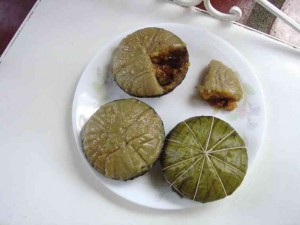
Three days after Supertyphoon “Yolanda” wreaked havoc across the country, we waited for any word from my husband’s family in Tacloban. We scanned the news channels, local and foreign, to know the situation in Leyte. And because the news was grim, we worried about my sister-in-law, her husband, their children and grandchildren.
At last my nephew was able to get through and said everyone was okay, that the house was waist-deep in water but was intact. He had cycled to a barrio where he heard one could call because there was cell-phone signal. He had to preserve the phone’s battery life, so the message was short. But what great relief it brought us.
Mana Pat, the eldest in her family, taught botany for years in Tacloban. One would think that her job as teacher, as school administrator, and a mother of nine children should take up all of her time. But she had time to cook food for the home, and some that she also sold.
Leyte version
Her suman latik was made after school—the same rice cake called suman sa lihiya elsewhere. But the Leyte version was wrapped in hagikhik leaves instead of banana leaves and shaped as triangular pieces, rather than rectangular. The latik is the syrup made from a mix of coconut milk and panocha, then poured on top of the suman.
Mana Pat tried to teach me how to make this. The mixture was easy enough, but when it came to wrapping the processed rice grains, they slipped out of my badly folded leaf.
I remember that she raised chicken in a small pen at the back of her house. Once in a while, a neighbor would knock, and she knew it was chicken that they wanted.
However, those were not the native chicken she favored when cooking hinatukang manok, the cut pieces cooked in coconut milk and chicken blood. It is her recipe that we use to this day; from her we learned to place the chicken blood into the grated coconut before squeezing out the kakang gata (first press cream) and the gata (milk from the second pressing).
And then there were her made-to-order chiffon cakes. In most provinces, there is no need to decorate cakes with icing. Bare cakes will do for special events, and hers were always perfect.
She sold products of a cosmetic company as well, so we can presume that her every waking hour was occupied managing her home, working in school and tending to her businesses. She
also made sure the house of her parents in Barugo, 50 km from Tacloban, was clean and secure.
Cheap crabs
Whenever we visited, she always had time to sit and just talk with us or to bring us to market to buy what we looked forward to eating there or bringing home—masag (blue crabs or alimasag) and sisi (tiny oysters) in brine. Because the crabs were cheap compared to what could be bought in Manila, she always scolded my husband, who did the marketing, against haggling with the sellers.
She was my best source on Waray cooking. Whenever I had questions, it took only a long-distance call to her to get answers. One time, I asked her why paksiw (cooking in vinegar) was sometimes called paksiu in Leyte. She said the term was usually used by people from the barrios.
Because she was the eldest grandchild, she witnessed how her grandmother and her aunts cooked, which made for great stories about how specialties were made, like the buttery cookies shaped like chicken legs called roscas, and the saltier boat-shaped de caña.
After typhoon Yolanda, many of my friends asked about Mana Pat, especially those who had researched about Leyte cooking. She referred them to people they could interview, even arranged transportation for them or accompanied them to market. Sometimes, ingredients were brought to her house which she then cooked, and while she did, she gave their scientific names and how these are called locally.
There were times we used her home to photograph the food, such as the binagol, sweets made from a kind of yam, and the bocayo, grated coconut placed back inside the coconut shell, sealed but with holes on the shell to let in the liquid sugar cooking in big vats.
Family reunion
When she called to invite us to come to Leyte and celebrate her birthday, we thought a family reunion was long overdue. We were also thinking of food we wanted to bring home—sisi, masag, suman latik, roscas, de caña and, hopefully, humba, chunks of pork braised in soy sauce with salted black beans and peanuts.
Three days before we were to fly to Tacloban, however, the typhoon came. We were hoping that everything would be over by the time we were set to go. We never imagined the magnitude of the destruction.
The best gift, of course, for Mana Pat is that her family is intact. Most of the family members were taken by her son and his friend in two cars that came from Manila to Tacloban and then back to Manila. Mana Pat stayed behind, but it looks like she will soon have to leave her home, even if temporarily.
It will be a while before we can go back to Leyte, to Tacloban and to the hometown of Barugo. But then home can be any place where the family is.
E-mail pinoyfood04@yahoo.com